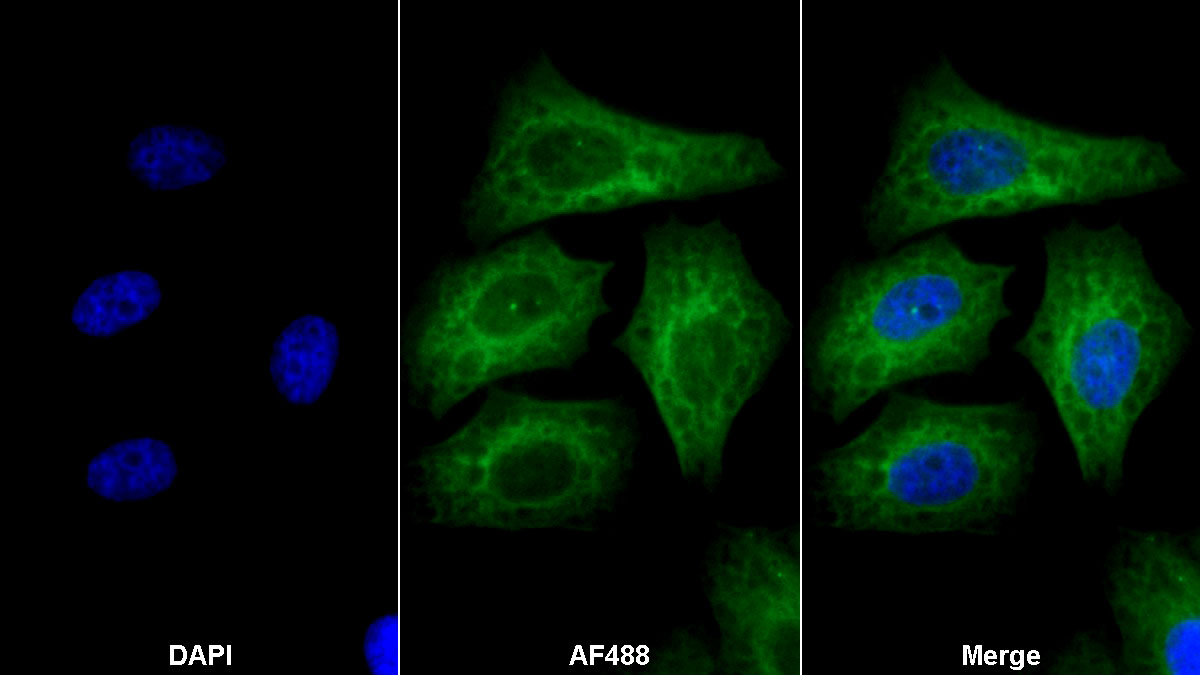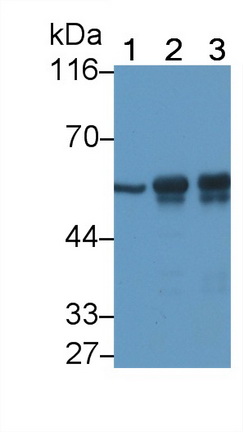Monoclonal Antibody to Tubulin Beta (TUBb) 

TUB-B; TUBB5; TUBB1; M40
- UOM
- FOB US$ 130.00 US$ 302.00 US$ 432.00 US$ 1,080.00 US$ 4,320.00
- Quantity
Overview
Properties
- Product No.MAB870Hu25
- Organism SpeciesHomo sapiens (Human) Same name, Different species.
- ApplicationsWB; ICC/IF
If the antibody is used in flow cytometry, please check FCM antibodies.
Research use only - DownloadInstruction Manual
- CategoryNeuro scienceDevelopmental science
- SourceMonoclonal antibody preparation, Host Mouse
- Ig Isotype IgG2b Kappa, Clone Number C4-1
- PurificationProtein A + Protein G affinity chromatography
- LabelNone
- Immunogen RPB870Hu01-Recombinant Tubulin Beta (TUBb)
- Buffer FormulationPBS, pH7.4, containing 0.02% NaN3, 50% glycerol.
- TraitsLiquid, Concentration 1mg/mL
Sign into your account
Share a new citation as an author
Upload your experimental result
Review

Contact us
Please fill in the blank.
Specifity
The antibody is a mouse monoclonal antibody raised against TUBb. It has been selected for its ability to recognize TUBb in immunohistochemical staining and western blotting.
Usage
Western blotting: 0.5-2µg/mL;
Immunohistochemistry: 5-20µg/mL;
Immunocytochemistry: 5-20µg/mL;
Optimal working dilutions must be determined by end user.
Storage
Store at 4°C for frequent use. Stored at -20°C in a manual defrost freezer for two year without detectable loss of activity. Avoid repeated freeze-thaw cycles.
Stability
The thermal stability is described by the loss rate. The loss rate was determined by accelerated thermal degradation test, that is, incubate the protein at 37°C for 48h, and no obvious degradation and precipitation were observed. The loss rate is less than 5% within the expiration date under appropriate storage condition.
Organism Species More: Rattus norvegicus (Rat), Sus scrofa; Porcine (Pig)Giveaways
Increment services
-
 Antibody Labeling Customized Service
Antibody Labeling Customized Service
-
 Protein A/G Purification Column
Protein A/G Purification Column
-
 Staining Solution for Cells and Tissue
Staining Solution for Cells and Tissue
-
 Positive Control for Antibody
Positive Control for Antibody
-
 Tissue/Sections Customized Service
Tissue/Sections Customized Service
-
 Phosphorylated Antibody Customized Service
Phosphorylated Antibody Customized Service
-
 Western Blot (WB) Experiment Service
Western Blot (WB) Experiment Service
-
 Immunohistochemistry (IHC) Experiment Service
Immunohistochemistry (IHC) Experiment Service
-
 Immunocytochemistry (ICC) Experiment Service
Immunocytochemistry (ICC) Experiment Service
-
 Flow Cytometry (FCM) Experiment Service
Flow Cytometry (FCM) Experiment Service
-
 Immunoprecipitation (IP) Experiment Service
Immunoprecipitation (IP) Experiment Service
-
 Immunofluorescence (IF) Experiment Service
Immunofluorescence (IF) Experiment Service
-
 Buffer
Buffer
-
 DAB Chromogen Kit
DAB Chromogen Kit
-
 SABC Kit
SABC Kit
-
 Long-arm Biotin Labeling Kit
Long-arm Biotin Labeling Kit
-
 Real Time PCR Experimental Service
Real Time PCR Experimental Service
Citations
- Synthesis and cytotoxic activity of certain trisubstituted azetidin-2-one derivatives as a cis-restricted combretastatin A-4 analoguespubmed:27747473
- New 3-Substituted-2-(4-hydroxyanilino)pyridine Derivatives: Synthesis, Antitumor Activity, and Tubulin Polymerization Inhibition.pubmed:28150327
- Novel Beta-Tubulin-Immobilized Nanoparticles Affinity Material for Screening β-Tubulin Inhibitors from a Complex Mixturepubmed:28112513
- Design, synthesis and biological evaluation of chromenopyrimidines as potential cytotoxic agentsPubmed:29779400
- Design and synthesis of novel 5-(4-chlorophenyl) furan derivatives with inhibitory activity on tubulin polymerizationPubmed:29966433
- Biochemical characterization of the PHARC associated serine hydrolase ABHD12 reveals its preference for very long chain lipidsPubmed: 30237167
- Design, synthesis, and screening of amino thiophene carboxamide derivatives on hepatocellular carcinomaas VEGFR-2InhibitorsPubmed: 30191744
- Potent combretastatin A-4 analogs containing 1, 2, 4-triazole: Synthesis, antiproliferative, anti-tubulin activity, and docking studyPubmed: 31536891
- Early diagnosis of Alzheimer's disease in blood using a disposable electrochemical microfluidic platformPubmed: 32207606
- Tubulin Inhibitors: Discovery of a New Scaffold Targeting Extra-binding Residues within the Colchicine Site through Anchoring Substituents Properly Adapted to their …Pubmed: 32325332
- Ginger and turmeric lipid-solubles attenuate heated oil-induced cardio-hepatic oxidative stress via the upregulation of NRF2 and decrease blood pressure in ratsPubmed: 33028437
- Design, Synthesis and Screening of Benzimidazole Containing Compounds with Methoxylated Aryl Radicals as Cytotoxic Molecules on (HCT-116) Colon …Pubmed: 33158579
- Cytotoxicity, in silico predictions and molecular studies for androstane heterocycle compounds revealed potential antitumor agent against lung cancer cells33300466
- Bufalin Induced Mitochondrial Dysfunction Promotes Apoptosis of Glioma Cells by Regulating Annexin A2 and DRP1 Proteins
- Bufalin induces mitochondrial dysfunction and promotes apoptosis of glioma cells by regulating Annexin A2 and DRP1 protein expression34376212
- Curcumin derivative ST09 modulates the miR-199a-5p/DDR1 axis and regulates proliferation and migration in ovarian cancer cells34837026







